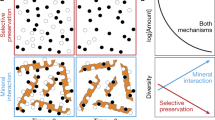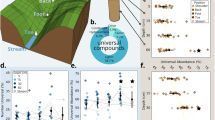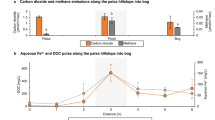Abstract
Organic matter decomposition in soils and terrestrial sediments has a prominent role in the global carbon cycle. Carbon stocks in anoxic environments, such as wetlands and the subsurface of floodplains, are large and presumed to decompose slowly. The degree of microbial respiration in anoxic environments is typically thought to depend on the energetics of available terminal electron acceptors such as nitrate or sulfate; microbes couple the reduction of these compounds to the oxidation of organic carbon. However, it is also possible that the energetics of the organic carbon itself can determine whether it is decomposed. Here we examined water-soluble organic carbon by Fourier-transform ion-cyclotron-resonance mass spectrometry to compare the chemical composition and average nominal oxidation state of carbon—a metric reflecting whether microbial oxidation of organic matter is thermodynamically favourable—in anoxic (sulfidic) and oxic (non-sulfidic) floodplain sediments. We observed distinct minima in the average nominal oxidation state of water-soluble carbon in sediments exhibiting anoxic, sulfate-reducing conditions, suggesting preservation of carbon compounds with nominal oxidation states below the threshold that makes microbial sulfate reduction thermodynamically favourable. We conclude that thermodynamic limitations constitute an important complement to other mechanisms of carbon preservation, such as enzymatic restrictions and mineral association, within anaerobic environments.
This is a preview of subscription content, access via your institution
Access options
Access Nature and 54 other Nature Portfolio journals
Get Nature+, our best-value online-access subscription
$29.99 / 30 days
cancel any time
Subscribe to this journal
Receive 12 print issues and online access
$259.00 per year
only $21.58 per issue
Buy this article
- Purchase on Springer Link
- Instant access to full article PDF
Prices may be subject to local taxes which are calculated during checkout



Similar content being viewed by others
References
Ciais, P. et al. in Climate Change 2013: The Physical Science Basis (IPCC, Cambridge Univ. Press, 2013).
Gurwick, N. P. et al. Mineralization of ancient carbon in the subsurface of riparian forests. J. Geophys. Res. 113, G02021 (2008).
Gurwick, N. P. et al. Microbially available carbon in buried riparian soils in a glaciated landscape. Soil Biol. Biochem. 40, 85–96 (2008).
Oost, K. V. et al. Legacy of human-induced C erosion and burial on soil–atmosphere C exchange. Proc. Natl Acad. Sci. USA 109, 19492–19497 (2012).
Batson, J. et al. Soil greenhouse gas emissions and carbon budgeting in a short-hydroperiod floodplain wetland. J. Geophys. Res. 120, 2014JG002817 (2015).
Marín-Spiotta, E. et al. Paradigm shifts in soil organic matter research affect interpretations of aquatic carbon cycling: transcending disciplinary and ecosystem boundaries. Biogeochemistry 117, 279–297 (2014).
Jin, Q. & Bethke, C. M. Predicting the rate of microbial respiration in geochemical environments. Geochim. Cosmochim. Acta 69, 1133–1143 (2005).
Keiluweit, M., Nico, P. S., Kleber, M. & Fendorf, S. Are oxygen limitations under recognized regulators of organic carbon turnover in upland soils? Biogeochemistry 127, 157–171 (2016).
Fenchel, T., King, G. M. & Blackburn, T. H. Bacterial Biogeochemistry 3rd edn, 1–34 (Academic, 2012).
Burns, R. G. et al. Soil enzymes in a changing environment: current knowledge and future directions. Soil Biol. Biochem. 58, 216–234 (2013).
Kleber, M., Sollins, P. & Sutton, R. A conceptual model of organo-mineral interactions in soils: self-assembly of organic molecular fragments into zonal structures on mineral surfaces. Biogeochemistry 85, 9–24 (2007).
Jokic, A., Cutler, J. N., Ponomarenko, E., van der Kamp, G. & Anderson, D. W. Organic carbon and sulphur compounds in wetland soils: insights on structure and transformation processes using K-edge XANES and NMR spectroscopy. Geochim. Cosmochim. Acta 67, 2585–2597 (2003).
LaRowe, D. E. & Van Cappellen, P. Degradation of natural organic matter: a thermodynamic analysis. Geochim. Cosmochim. Acta 75, 2030–2042 (2011).
Chaopricha, N. T. & Marín-Spiotta, E. Soil burial contributes to deep soil organic carbon storage. Soil Biol. Biochem. 69, 251–264 (2014).
Tockner, K. & Stanford, J. Review of: riverine flood plains: present state and future trends. Environ. Conserv. 29, 308–330 (2002).
Lair, G. J. et al. How do long-term development and periodical changes of river–floodplain systems affect the fate of contaminants? results from European rivers. Environ. Pollut. 157, 3336–3346 (2009).
Blazejewski, G. A., Stolt, M. H., Gold, A. J., Gurwick, N. & Groffman, P. M. Spatial distribution of carbon in the subsurface of riparian zones. Soil Sci. Soc. Am. J. 73, 1733–1740 (2009).
Ricker, M. C. & Lockaby, B. G. Soil organic carbon stocks in a large eutrophic floodplain forest of the southeastern Atlantic coastal plain, USA. Wetlands 35, 291–301 (2015).
Janot, N. et al. Physico-chemical heterogeneity of organic-rich sediments in the Rifle Aquifer, CO: impact on uranium biogeochemistry. Environ. Sci. Technol. 50, 46–53 (2016).
Claypool, G. E. & Kaplan, I. R. in Natural Gases in Marine Sediments (ed. Kaplan, I. R.) 99–139 (Springer, 1974).
Froelich, P. N. et al. Early oxidation of organic matter in pelagic sediments of the eastern equatorial Atlantic: suboxic diagenesis. Geochim. Cosmochim. Acta 43, 1075–1090 (1979).
Postma, D. & Jakobsen, R. Redox zonation: equilibrium constraints on the Fe(III)/SO4-reduction interface. Geochim. Cosmochim. Acta 60, 3169–3175 (1996).
Tfaily, M. M. et al. Advanced solvent based methods for molecular characterization of soil organic matter by high-resolution mass spectrometry. Anal. Chem. 87, 5206–5215 (2015).
Kim, S., Kramer, R. W. & Hatcher, P. G. Graphical method for analysis of ultrahigh-resolution broadband mass spectra of natural organic matter, the Van Krevelen diagram. Anal. Chem. 75, 5336–5344 (2003).
Hodgkins, S. B. et al. Changes in peat chemistry associated with permafrost thaw increase greenhouse gas production. Proc. Natl Acad. Sci. USA 111, 5819–5824 (2014).
Hedges, J. I. et al. The molecularly-uncharacterized component of nonliving organic matter in natural environments. Org. Geochem. 31, 945–958 (2000).
Marchand, C., Albéric, P., Lallier-Vergès, E. & Baltzer, F. Distribution and characteristics of dissolved organic matter in mangrove sediment pore waters along the coastline of French Guiana. Biogeochemistry 81, 59–75 (2006).
Seidel, M. et al. Biogeochemistry of dissolved organic matter in an anoxic intertidal creek bank. Geochim. Cosmochim. Acta 140, 418–434 (2014).
Oades, J. M. The retention of organic matter in soils. Biogeochemistry 5, 35–70 (1988).
Lorenz, K., Lal, R., Preston, C. M. & Nierop, K. G. J. Strengthening the soil organic carbon pool by increasing contributions from recalcitrant aliphatic bio(macro)molecules. Geoderma 142, 1–10 (2007).
Rumpel, C. & Kögel-Knabner, I. Deep soil organic matter—a key but poorly understood component of terrestrial C cycle. Plant Soil 338, 143–158 (2010).
Rillig, M. C., Caldwell, B. A., Wösten, H. A. B. & Sollins, P. Role of proteins in soil carbon and nitrogen storage: controls on persistence. Biogeochemistry 85, 25–44 (2007).
Koch, B. P. & Dittmar, T. From mass to structure: an aromaticity index for high-resolution mass data of natural organic matter. Rapid Commun. Mass Spectrom. 20, 926–932 (2006).
Schmidt, M. W. I. et al. Persistence of soil organic matter as an ecosystem property. Nature 478, 49–56 (2011).
Ravel, B. & Newville, M. ATHENA, ARTEMIS, HEPHAESTUS: data analysis for X-ray absorption spectroscopy using IFEFFIT. J. Synchrotron Radiat. 12, 537–541 (2005).
Prietzel, J. et al. Sulfur speciation in soil by S K-Edge XANES spectroscopy: comparison of spectral deconvolution and linear combination fitting. Environ. Sci. Technol. 45, 2878–2886 (2011).
Cances, B. et al. XAS evidence of As(V) association with iron oxyhydroxides in a contaminated soil at a former arsenical pesticide processing plant. Environ. Sci. Technol. 39, 9398–9405 (2005).
Noël, V. et al. EXAFS analysis of iron cycling in mangrove sediments downstream a lateritized ultramafic watershed (Vavouto Bay, New Caledonia). Geochim. Cosmochim. Acta 136, 211–228 (2014).
Heymann, K., Lehmann, J., Solomon, D., Schmidt, M. W. I. & Regier, T. C 1s K-edge near edge X-ray absorption fine structure (NEXAFS) spectroscopy for characterizing functional group chemistry of black carbon. Org. Geochem. 42, 1055–1064 (2011).
Wan, J., Tyliszczak, T. & Tokunaga, T. K. Organic carbon distribution, speciation, and elemental correlations within soil microaggregates: applications of STXM and NEXAFS spectroscopy. Geochim. Cosmochim. Acta 71, 5439–5449 (2007).
Solomon, D. et al. Carbon (1s) NEXAFS spectroscopy of biogeochemically relevant reference organic compounds. Soil Sci. Soc. Am. J. 73, 1817–1830 (2009).
Minor, E. C., Steinbring, C. J., Longnecker, K. & Kujawinski, E. B. Characterization of dissolved organic matter in Lake Superior and its watershed using ultrahigh resolution mass spectrometry. Org. Geochem. 43, 1–11 (2012).
Stubbins, A. et al. Illuminated darkness: molecular signatures of Congo River dissolved organic matter and its photochemical alteration as revealed by ultrahigh precision mass spectrometry. Limnol. Oceanogr. 55, 1467–1477 (2010).
Kujawinski, E. B. & Behn, M. D. Automated analysis of electrospray ionization fourier transform ion cyclotron resonance mass spectra of natural organic matter. Anal. Chem. 78, 4363–4373 (2006).
Šantl-Temkiv, T. et al. Hailstones: a window into the microbial and chemical inventory of a storm cloud. PLoS ONE 8, e53550 (2013).
Acknowledgements
This work was supported by the US Department of Energy (DOE) Office of Science, Office of Biological and Environmental Research (BER), through the SLAC National Accelerator Laboratory Scientific Focus Area (SFA) (Contract No. DE-AC02-76SF00515). Work by S.F. was supported by the US DOE BER Terrestrial Ecosystem Program (Award Number DE-FG02-13ER65542). Work by M.M.T. was conducted at EMSL, a DOE Office of Science User Facility sponsored by the Office of Biological and Environmental Research and located at Pacific Northwest National Laboratory. Field operations at the Rifle site and work by K.W.H. was supported through the Lawrence Berkeley National Laboratory’s Sustainable Systems SFA (US DOE BER, contract DE-AC02-05CH11231). Additional funding for field operations was provided by the DOE Office of Legacy Management (DOE-LM). This study could not have been completed without the logistical support of the DOE-LM staff and contractors. Special thanks to R. Bush, R. H. Johnson and W. L. Dam. The authors are very grateful for sampling and analytical efforts provided by J. S. L. Pacheco, E. Cardarelli, L. Barraghan, G. Li, D. Turner, L. Pasa-Tolic, R. Chu, T. Z. Regier and J. J. Dynes.
Author information
Authors and Affiliations
Contributions
This work was originally conceived by K.B. and S.F., with substantial contributions from J.R.B.; field activities were designed and coordinated by K.H.W., S.E.B., J.R.B. and V.N., with input from K.B. and S.F.; V.N. designed and carried out the inorganic chemical characterization activities, with input from J.R.B.; K.B. designed and carried out the organic matter characterization approach, with input from S.E.B., S.F., J.R.B. and M.M.T.; M.M.T. performed the FT-ICR-MS analyses and data processing; K.B. compiled the data and performed statistical analyses. The manuscript and supporting information was written by K.B. with input from all co-authors, particularly S.F.
Corresponding author
Ethics declarations
Competing interests
The authors declare no competing financial interests.
Supplementary information
Supplementary Information
Supplementary Information (PDF 1356 kb)
Rights and permissions
About this article
Cite this article
Boye, K., Noël, V., Tfaily, M. et al. Thermodynamically controlled preservation of organic carbon in floodplains. Nature Geosci 10, 415–419 (2017). https://doi.org/10.1038/ngeo2940
Received:
Accepted:
Published:
Issue Date:
DOI: https://doi.org/10.1038/ngeo2940
This article is cited by
-
The chemical succession in anoxic lake waters as source of molecular diversity of organic matter
Scientific Reports (2024)
-
The variation of DOM during long distance water transport by the China South to North Water Diversion Scheme and impact on drinking water treatment
Frontiers of Environmental Science & Engineering (2024)
-
A conserved interdomain microbial network underpins cadaver decomposition despite environmental variables
Nature Microbiology (2024)
-
Coupled iron cycling and organic matter transformation across redox interfaces
Nature Reviews Earth & Environment (2023)
-
Eco-morphodynamic carbon pumping by the largest rivers in the Neotropics
Scientific Reports (2023)



